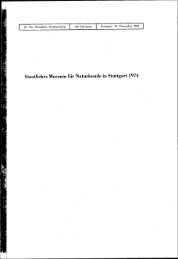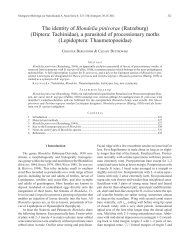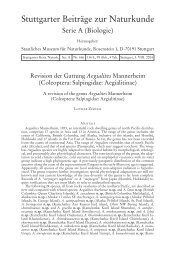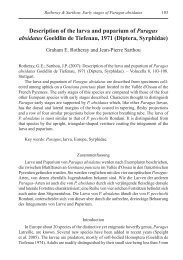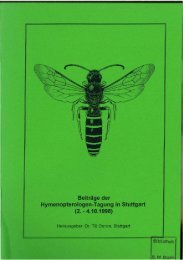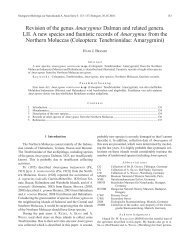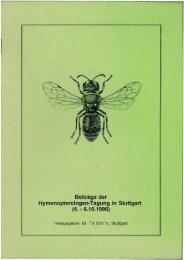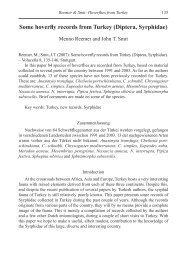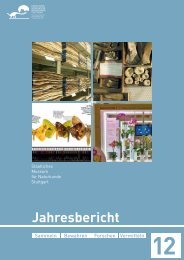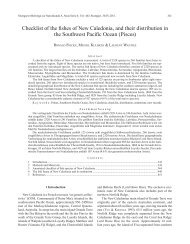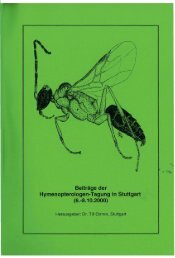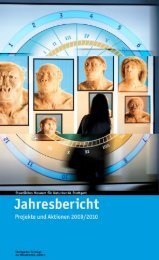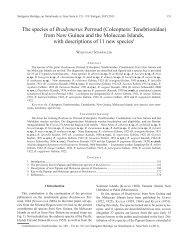Serie A (Biologie) - Staatliches Museum für Naturkunde Stuttgart
Serie A (Biologie) - Staatliches Museum für Naturkunde Stuttgart
Serie A (Biologie) - Staatliches Museum für Naturkunde Stuttgart
Create successful ePaper yourself
Turn your PDF publications into a flip-book with our unique Google optimized e-Paper software.
schawaller, oriental species of bradymerus 63– Body length 5.0–7.0 mm; joint elytra shorter (Fig. 16). Basal piece of aedeagus short(Fig. 87). – Widespread species . . . . . . . . . . . . . . . . . . . . . . . . . . . . . . . . . . . . . . B. clathratus62 Last 5 antennomeres forming a club . . . . . . . . . . . . . . . . . . . . . . . . . . . . . . . . . . . . . . . . . . 63– Last 6 antennomeres forming a club . . . . . . . . . . . . . . . . . . . . . . . . . . . . . . . . . . . . . . . . . . 6663 Body length 6.0 mm; anterior corners of pronotum extremely protruding, acute (Fig. 70).Aedeagus as in Fig. 133 . . . . . . . . . . . . . . . . . . . . . . . . . . . . . . . . . . . . . . B. sumatranus n. sp.– Body length 6.5–9.0 mm; anterior corners of pronotum not extremely protruding, round. . . . . . . . . . . . . . . . . . . . . . . . . . . . . . . . . . . . . . . . . . . . . . . . . . . . . . . . . . . . . . . . . . . . . . . . 6464 Pronotum widest in the middle; alternate elytral intervals 3 (only anteriorly), 5, 7 withkeels, intervals 2, 5, 7 flat and without granules (Fig. 13). Aedeagus as in Fig. 81 . . . . . . . .. . . . . . . . . . . . . . . . . . . . . . . . . . . . . . . . . . . . . . . . . . . . . . . . . . . . . . . . . . . . . . . B. bifurcatus– Pronotum widest in the anterior third; structure of elytral intervals different . . . . . . . . 6565 Alternate elytral interval 3 posteriorly with a low keel, intervals 5 and 7 with complete andhigh keels, keels with granules (Fig. 14). Aedeagus as in Fig. 84 . . . . . B. bocakorum n. sp.– Elytral intervals 3 posteriorly, 5 and 6 anteriorly, 7 completely with keels, keels withoutgranules (Fig. 60) . . . . . . . . . . . . . . . . . . . . . . . . . . . . . . . . . . . . . . . . . . . . . . . . . B. planicollis66 Alternate elytral intervals 2, 4, 6 only with a few and feeble granules (Fig. 54). Aedeagus asin Fig. 120 . . . . . . . . . . . . . . . . . . . . . . . . . . . . . . . . . . . . . . . . . . . . . . . . . . . . . . . B. mcgregori– Alternate elytral intervals 2, 4, 6 either with keels or granules in a different pattern . . . 6767 Small species (body length 5.5–7.0 mm) with long and parallel elytra (Fig. 25). Aedeagus asin Fig. 94 . . . . . . . . . . . . . . . . . . . . . . . . . . . . . . . . . . . . . . . . . . . . . . . . . . . . B. emasicus n. sp.– Somewhat larger species in the average (body length 6.0–9.0 mm) with broader and morecompact elytra . . . . . . . B. elongatus (Java), B. kaszabi n. sp. (Sulawesi), B. kodadai n. sp.(Borneo), B. lombokicus n. sp. (Lombok), B. sumbawaicus n. sp. (Sumbawa, Sulawesi)[The identification of these five quite similar species (mostly endemic insular populations)is only possible by a fastidious comparison of shape and structure of the pronotum, patternof the keels and granules on the elytral intervals, and shape of the aedeagus; see thedetails in the descriptions and diagnoses.]8 ReferencesBOUCHARD, P., LAWRENCE, J. F., DAVIES, A. & NEWTON, A. F. (2005): Synoptic classificationof the World Tenebrionidae (Insecta: Coleoptera) with a review of family-group names.– Annales Zoologici 55: 499–530.FAIRMAIRE, L. (1893): Coléoptères nouveaux des Indes orientales, de la famille des Scarabaeidae,Rhipidoceridae, Tenebrionidae et Oedemeridae. – Notes from the Leyden <strong>Museum</strong>15: 17–64.GEBIEN, H. (1913): Die Tenebrioniden der Philippinen. – Philippine Journal of Science 8:373–433.GEBIEN, H. (1925): Die Tenebrioniden (Coleoptera) des indomalayischen Gebietes, unterBerücksichtigung der benachbarten Faunen, III. Die Gattungen Bradymerus, Chaetopsia,Danodema, und Dicraeosis. – Philippine Journal of Science 26: 535–576.GEBIEN, H. (1936–1944): Katalog der Tenebrioniden (Col. Heteromera). – Part 1 (1936): Pubblicazionidel Museo entomologico PIETRO ROSSI 2; Part 2 (1938–1942): Mitteilungender Münchener entomologischen Gesellschaft 28–32; Part 3 (1942–1944): Mitteilungender Münchener entomologischen Gesellschaft 32–34.KASZAB, Z. (1954): Über die von Herrn J. KLAPPERICH in der chinesischen Provinz Fukiengesammelten Tenebrioniden (Coleoptera). – Annales historico-naturales Musei nationalishungarici 5: 247–264.KASZAB, Z. (1980): Angaben zur Kenntnis der Tenebrioniden Nordvietnams (Coleoptera). –Annales historico-naturales Musei nationalis hungarici 72: 169–221.KULZER, H. (1951): Fünfter Beitrag zur Kenntnis der Tenebrioniden. – Entomologische Arbeitenaus dem <strong>Museum</strong> G. FREY 2: 461–573.KULZER, H. (1957): Insects of Micronesia. Coleoptera: Tenebrionidae. – Insects of Micronesia17: 185–256.SHIBATA, T. (1980): Notes on Tenebrionidae from Taiwan and Japan, III. (Coleoptera). –Entomological Review of Japan 34: 63–74.



